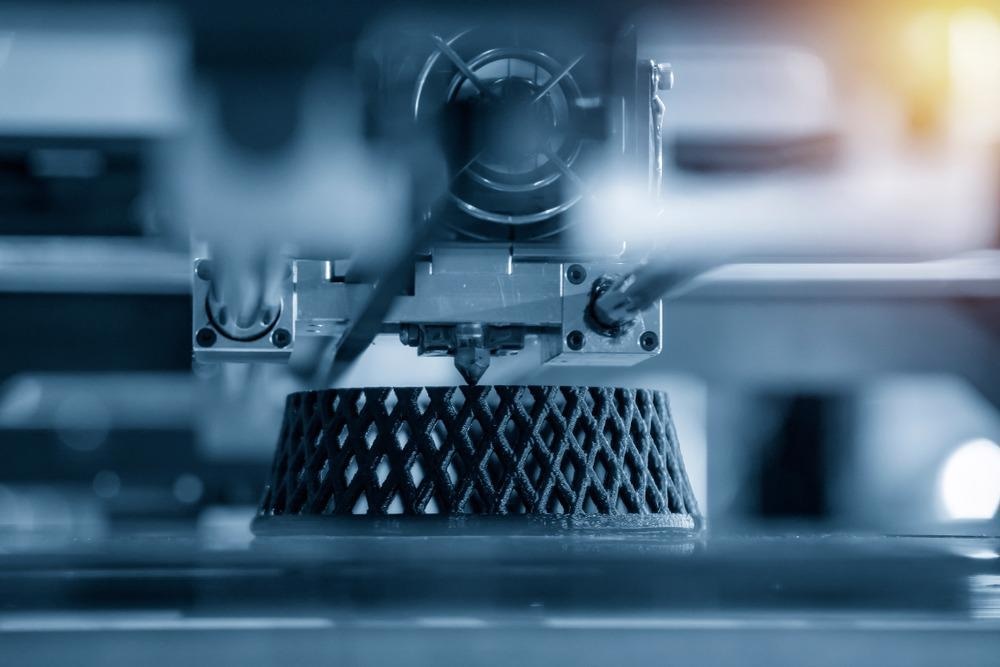In an article published in the journal ACS Omega, aerosol jet printing (AJP) of graphene and single-walled carbon nanotube (SWCNT) designs on realistic robust plasma electrolytically oxidized (PEO) aluminum (Al) blocks, that have the potential to be excellent heat sink materials, was reported.
 Study: Aerosol Jet Printing of Graphene and Carbon Nanotube Patterns on Realistically Rugged Substrates. Image Credit: Pixel B/Shutterstock.com
Study: Aerosol Jet Printing of Graphene and Carbon Nanotube Patterns on Realistically Rugged Substrates. Image Credit: Pixel B/Shutterstock.com
Parametric space screening provided a foundation for logical procedure advancement for graphene and SWCNT AJP on application-based, hard substrates.
Graphene and Carbon Nanotubes as Thermal Interconnects
Graphene and CNTs exhibit intriguing qualities such as strong heat conduction, very high electric current capacity, mechanical rigidity, and chemical stability. As a result, they are very appealing as device components in electronic systems, lights, and sensors.
These materials are being evaluated as potential materials for electric and thermal interconnection in optoelectronics owing to their superior electrical and thermal conductance.
Coating with carbon nanotubes or graphene as intricate thermal conductors with a good connection to heat drain components is critical for said thermal interconnections, particularly in hybrid printing/surface-mount-technology approaches.
Actual heat drain components, in contrast to smooth electronic-grade materials such as foils or wafers, are usually coarse machined-metal blocks with very rough surfaces. As a result, the coating methods for carbon nanotubes and graphene thermal interconnects must be suitable with such rough substrate surfaces.
Benefits of Additive Manufacturing
Additive manufacturing (AM) techniques of graphene and carbon nanotubes, such as inkjet printing or aerosol jet printing (AJP), are flexible methods for creating electric and thermal interconnects. In contrast with rival "top-down" device design methods, AM provides a number of benefits.
For starters, it enables graphene and carbon nanotubes to be deposited on a variety of substrates without requiring elevated temperatures or chemically active settings, leading to better substrate preservation.
Secondly, AM produces patterned deposits by default, eliminating any requirement of time-consuming postdeposition relocation, lithographic, and subtractive etching procedures that are required to achieve device patterning in many traditional manufacturing methods.
Third, by using economical liquid-stage processing of graphene and CNTs, precursory inks for AM may be produced on a large scale.
Inkjet Printing Vs. Aerosol Jet Printing
AJP is a really promising innovative direct writing AM technique that overcomes the limitations of inkjet printing: in this technique, the substance to be deposited is suspended within fine aerosolized particles produced by the AJP ink and then aimed in the form of a collimated spray onto the target substrate in an organized pattern.
Utilizing an aerosolized spray while coating broadens the viscosity range of viable AJP inks, allowing AJP to implant a larger variety of substances and greater solid mass loadings compared to inkjet printing. Furthermore, since the AJP aerosolized stream is collimated by 3D gas flow wrapping, consistent depositing is achieved across a range of nozzle–substrate stand-off distances (1–5 mm). As a result, AJP is well equipped for implantation on tough substrates.
AJP is the optimum approach for direct writing of graphene or carbon nanotube patterns on rough heat drain elements due to its flexible range of useable stand-off distances. Up to this point, unfortunately, no research has explored the AJP of graphene and carbon nanotubes on such realistic rough surfaces.
Main Focus of the Research
The parametric space of AJP of SWCNTs and graphene on realistic rough heat drain elements are investigated in this study. Plasma-electrolytically-oxidized (PEO) aluminum blocks were of special interest as nanocarbon AJP printing substrates.
PEO Al blocks of this kind are a critical material advancement for heat drains in thermal control for industrial LED integration. Through the printing of different testing designs on PEO Al blocks, AJP was compared with archetypal organic and aqueous graphene and SWCNT inks.
The anatomical, structural, and simple electric evaluation of the deposited AJP patterns at several length ranges demonstrated the viability of AJP printing of graphene and SWCNTs on realistic rough substrates.
Key Findings
AJP may easily accomplish complete coating of the rough substrates, along with complete coverage of the microscale pores, with the help of repeated cycles.
The ink system used, whether organic or aqueous solvents with or without supplementary additives, has a significant influence on the AJP outcomes. The ink used has a significant influence on the nanocarbon-based AJP coating morphology, such as crystalline integrity, deposit compactness, and inter-pass or intra-pass adherence in repeated passes.
The study found that AJP coatings on rough PEO Al blocks had characteristics comparable to AJP printing on commonly used standard flat glass platforms. This demonstrates that AJP is well-suited to printing nanocarbon patterns on realistic rough surfaces.
Continue reading: What Nanoparticles are Best for Additive Manufacturing and 3D Printing Applications?
Reference
Kaindl, R., Gupta, T. et al. (2021) Aerosol Jet Printing of Graphene and Carbon Nanotube Patterns on Realistically Rugged Substrates. ACS Omega. Available at: https://pubs.acs.org/doi/10.1021/acsomega.1c03871
Disclaimer: The views expressed here are those of the author expressed in their private capacity and do not necessarily represent the views of AZoM.com Limited T/A AZoNetwork the owner and operator of this website. This disclaimer forms part of the Terms and conditions of use of this website.